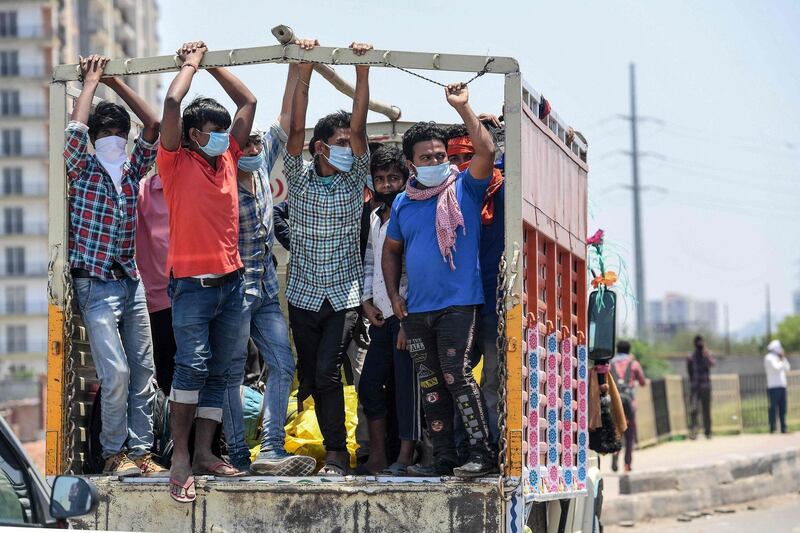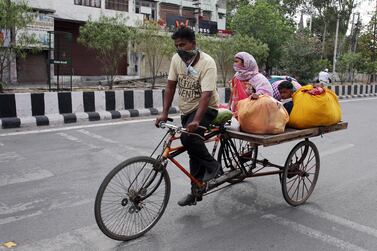The announcement of India's $266 billion (Dh976.9bn) economic stimulus package initially prompted euphoria among investors and businesses.
But as further details have emerged in an ongoing series of daily press conferences by the finance ministry, many have been left questioning whether the measures are the shot in the arm that the country's economy – battered by a nationwide lockdown – needs.
“While the announcement of the 20 trillion rupee stimulus scheme enthused the corporate sector and financial markets, the actual [details] are moving sentiment in the opposite direction,” says Sujan Hajra, the chief economist at Anand Rathi, a financial services company based in Mumbai.
At $266bn, India's economic package is one of the world's largest and is equivalent to about 10 per cent of its GDP.
“On the surface, its size is impressive compared to what other emerging markets have done,” says Mark Shirreff Matthews, the head of research for Asia at Julius Baer. “But scrutinising it more closely, economists estimate that about half of it consists of measures that had already been announced since the corona crisis started.”
The package was unveiled by India's prime minister in an address to the nation on Tuesday evening, in which he also referred to moving ahead with “bold reforms” and the need for the country to focus on becoming “self-reliant” as an economy, rather than one that depends heavily on imports from other countries. The Indian economy was already slowing down before the coronavirus outbreak struck.
The benchmark BSE Sensex on Wednesday rallied in response to the long-awaited announcement of the package. But by Friday, all of these gains had been wiped out, as the finance minster Nirmala Sitharaman has been gradually unveiling in tranches how the funds will be allocated.
“It was disappointing to see our markets failing at higher levels despite such a massive trigger,” says Sameet Chavan, the chief analyst, technical and derivatives at Mumbai-based Angel Broking.
Steps that have been announced so far include collateral-free loans for small and medium-sized companies and liquidity for sectors including power distribution. There will also be debt and equity funds amounting to $9.3bn to help stressed businesses. Measures to help the poor include free grains for migrant workers. On Friday, Ms Sitharaman announced initiatives focused on supporting farmers and fishermen. These included 1 trillion rupees ($13bn) of funds for loans for infrastructure development in the agriculture sector, such as warehouses and cold storage. She also talked about plans to help farmers secure fairer prices for their crops.
On Saturday, a fourth tranche of measures included structural reforms to the aviation and defence sectors, as well as plans to liberalise coal mining.
Commenting on these initiatives for the agriculture sector, B Gopkumar, the managing director of Axis Securities, says that “the government's thinking is long-term in improving the economic fundamentals in providing key support which can improve the supply chain, reduce wastage and better price realisations”.
“This will help in the creation of employment and lead to long term demand creation”, he says, but adds that “we do not foresee any major immediate benefits of the measures announced”.
There are still further details awaited on more tranches for the allocation of funds.
“While many of the measures offer humanitarian relief and are welcome, we await details on the reflation package, a spending push aimed at boosting aggregate demand,” says Kapil Gupta, an economist at Edelweiss, a financial services company headquartered in Mumbai.
“[Without] a demand boost, credit guarantees could prove inadequate. We emphasise that pre-Covid-19 the economy was already going through an extended slowdown with many indicators languishing at decadal lows.”
Mr Hajra describes the package as “well-meaning”, but points out that there seems to “be little fresh direct fiscal outlay”.
“Moreover, including certain ongoing and longer-term measures in the emergency stimulus package is confusing,” he adds.
Mumbai-based corporate lawyer Foram Shah, says “it's lot of money in India - provided there is a coherent plan to use the money for those at the receiving end of the lockdown shock, provided we have some transparency, a political will, real money”.
Stimulus is critical for India. GDP growth slowed to an almost seven-year low of 4.7 per cent in the quarter to the end of December, hampered by weak investment and consumer demand.
But things have worsened considerably amid the coronavirus pandemic.
India's lockdown began on March 25, bringing the economy to a virtual standstill and hurting businesses badly. It was one of the strictest lockdowns in the world, with most people only allowed to venture out to buy essential supplies.
In recent weeks, some business activity has resumed in a very limited capacity.
Some offices in parts of the country less affected by Covid-19 have been allowed to reopen with one-third of their workforce, and factories are gradually starting to reopen with fewer workers.
The third phase of the lockdown is due to end on Sunday and is set to be extended, although further relaxations are expected.
With the outbreak also hitting international trade and pushing the global economy into recession this year, Moody's Investors Service has cut its growth forecast for India for the current financial year, which began in April, to 0 per cent.
That is far short of the levels of about 8 per cent annually that India has been targeting as it aims to become a $5 trillion economy by 2025.
One of the primary reasons that India needs such growth levels is to create more jobs for its young population. But the lockdown has put many people out of work. Figures from think tank Centre For Monitoring Indian Economy reveal that the unemployment rate has surged to a record high – above 27 per cent.
Some business leaders are optimistic that the economic package will help ease the situation.
“The package will help provide more liquidity to our business,” says Ashok Pathare, the managing director of Paxchem, a Mumbai-based chemical manufacturing company. “These measures which are part of the package will encourage us to make investments, grow the supply chain and safeguard employment. We are optimistic that these policies along with the slogan “Vocal for Local” will enable Indian industries to bring millions of people back to work and minimise the impact of the Covid-19 crisis.”
The package was eagerly anticipated. Measures taken after the lockdown first came into effect included $22 billion economic package, which largely focused on poorer communities, with free food and some cash handouts. This was widely criticised for not being nearly enough. Action was also taken by the Reserve Bank of India, including a hefty emergency interest rate cut and a moratorium on loans.
The $266bn package's headline figure includes these measures that were already launched.
But there are concerns about how the rest will be funded.
Analysts say that it will have to be financed by issuing more government debt.
“The new fiscal stimulus will substantially push up India’s already-high public debt ratio,” Shilan Shah, the senior India economist at Capital Economics wrote in a research note. “Policymakers may have to resort to unusual steps to keep borrowing costs in check, including further financial repression – forcing savers to channel funds to the government – and a return to partially monetising the deficit [the central bank directly purchasing government bonds].”
He points out that issuing more government debt could be a concern “over the medium term given that debt levels in India are already high by emerging market standards”.
With an increase in spend by the government, SBI Research estimates that India's fiscal deficit could balloon to 7.9 per cent in the current financial year – double its earlier estimate of 3.5 per cent.

An expanding fiscal deficit is a worry because it could impact India's global ratings, which in turn impacts investment into the country. Ratings agencies Moody's and Fitch have warned that India's sovereign rating could be downgraded.
“This would probably happen in the context of a prolonged or deep slowdown in growth, with only limited prospects that the government would be able to restore stronger output through economic and institutional reforms,” according to Moody's.
But with the prime minister Mr Modi indicating in his speech last week that there will be a focus on “land, labour, liquidity and laws” reforms to improve manufacturing and the business environment, there are some hopes that the coronavirus pandemic will push India to accelerate changes that many believe have long been required, and could ultimately boost the economy.







